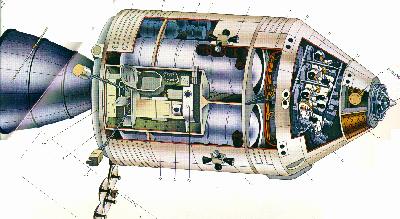
Comparitive views of the Apollo, Gemini, and Mercury Capsules, along with their respective launch vehicles
Image taken from the Internet


The Apollo moon rockets were sent aloft by the mighty Saturn V launch vehicles, which remained the largest Terran space vehicles untill well into the 21st century. Saturn V was also used to launch the Skylab space station into orbit. After the missions to the moon were over, the Apollo space capsules were still used to launch crews into Earth orbit, employing the much smaller Saturn Ib rockets. These missions included the historical joint Russian/American Apollo-Soyus link up mission along with the excursions to the Skylab space stations.


Comparitive view of American launch vehicles of the late 20th century.
Image taken from the internet.

Saturn vehicles: Saturn Ib, Saturn V, and Saturn V/Skylab
Image scanned from Quest for Space by C. Bongiorno
On January 27, 1967, the first major tragedy in the history of Terran space flight occured when the inside of the Apollo capsule caught fire while on the launch pad. At the time, the American space program was using only pure oxygen for life support, rather than the mush less combustable oxygen/nitorgen combination found naturally in Earth's atmosphere. As a result, a single spark caused the entire volume of oxygen within the capsule to ignite. Killed in the fire were astronauts Virgil I. "Gus" Grissom, Roger Chaffee, and Edward White.
The Apollo capsule consisted of three main modules for lunar landing missions, the lunar excursion module (LEM), the command module (CM), and the service module (SM). For Earth orbital flights, of course, the lunar module was not included. The command module was the area where the crew spent most of their time on their mission. It was a small, conical capsule with accomodations for three pople. Attached directly behind the CM was the SM, which housed the ships life support, experimental, navigational, and propulsion systems. Propulsion consisted of a single, large rocket engine at the rear with a set of four small RCS thrusters set at 90 degrees apart around the SM. The lunar module consisted of two stages, an ascent and a descent stage. The descent stage was left on the moon while the ascent stage rocketed back up to lunar orbit in order to rendezvous with the CM. In some cases, the ascent module was sent back to the lunar surface, crashing it in order to get seismic data on the lunar subsurface.


Cutaway view of the Lunar Module ascent stage
Image scanned from Quest for Space by C. Bongiorno
Specifications: